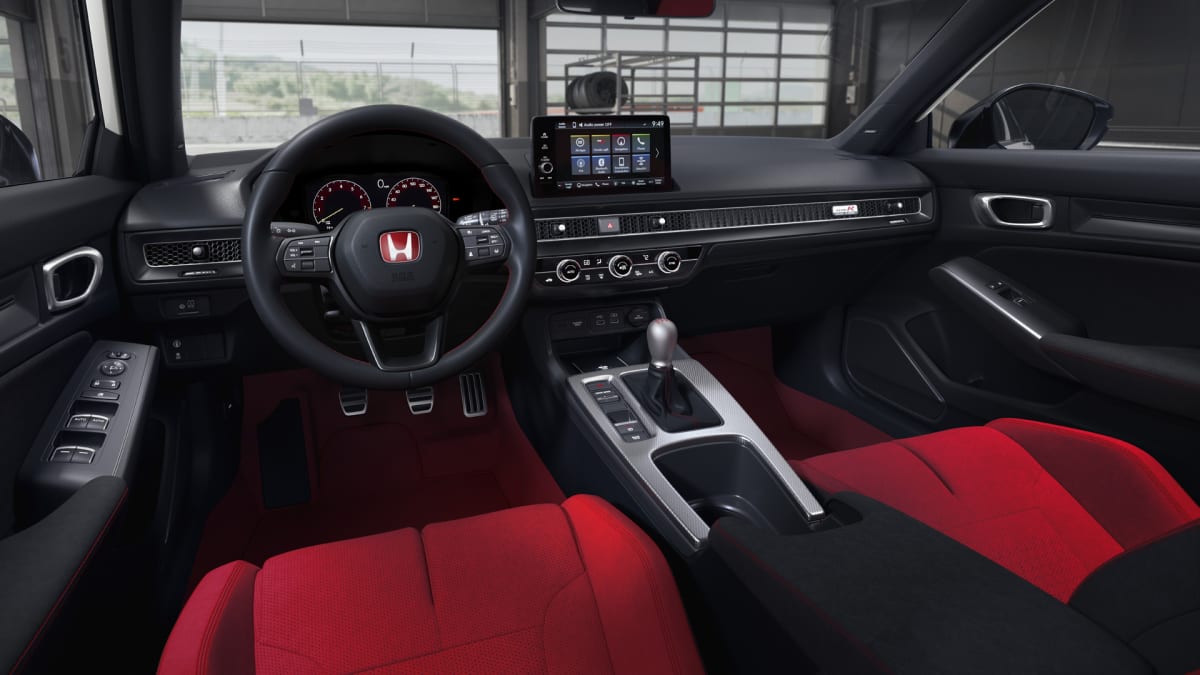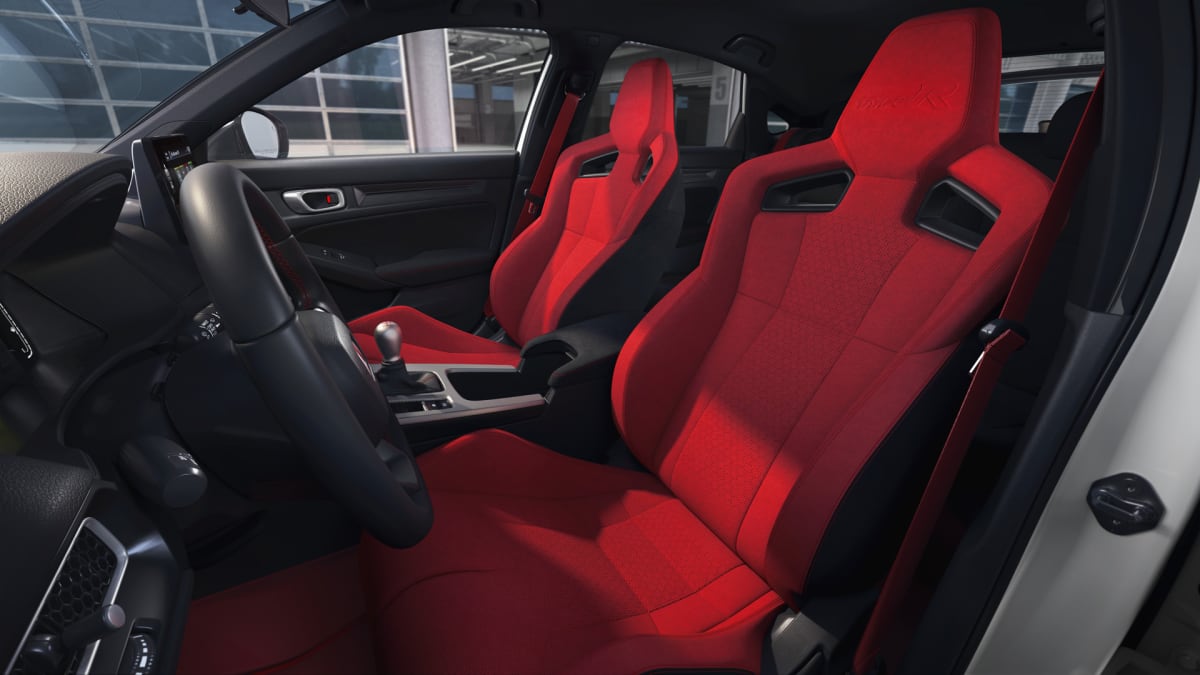2023 Honda Civic Type R First Drive Review: All grown up isn't so bad

SEARS POINT, Calif. – Is being “all grown up” such a bad thing? Listening to blink-182’s latest would suggest that, yep, it definitely can be. Being rough around the edges, a tad tacky and a lot loud don’t have to be problems, they can be the very things that draw people to a pop punk band, clothing style or a certain high-performance hatchback in the first place. Smooth out those edges, class things up and quiet things down, and before you know it, the magic’s lost.
Well, the 2023 Honda Civic Type R sure seems all grown up. The absurd vents of the outgoing model are gone, replaced by more restrained body work, courtesy the 11th generation Civic, but with added elements unique to the Type R’s widened body and aerodynamic enhancements. The front fascia and interior styling in particular are classier than what you’ll find with the Civic Si. The big wing remains, but it feels more like the earring and tattoo you kept into your 30s. Maybe it’s because I’m almost in my 40s, (ugh) but I see absolutely nothing wrong with this. The Type R magic is not lost.
The main reason for that is beneath the boy-racer visual flamboyance of the previous generation was a surprisingly refined car, complete with an adaptive suspension that would allow you to unapologetically bomb around a back road yet not beat you up on the drive to work. Your girlfriend or mother would be unlikely to complain about being driven in a Type R. It also wasn’t terribly noisy, the seats weren’t silly and the car’s ample power and torque could be judicially doled out. Basically, the Civic Type R as we’ve known it here in North America was never exactly unhinged.
That remains for 2023, but the performance envelope has nevertheless been enlarged thanks to a variety of chassis, powertrain, cooling and aerodynamic improvements beyond the inherent improvements made for Civic generation 11. It starts with a body that’s longer, lower and wider than its predecessor, with bulging fenders encasing wider tracks (1 inch front, 0.75 inch rear) than the standard Civic hatchback. And, once again, the Type R is hatchback-only, while the Civic Si is sedan-only. The body itself is stiffer and weight is minimized with a resign hatch and front bulkhead, and the continued use of an aluminum hood.
The Type R’s K20C 2.0-liter turbocharged inline-four gets pumped up to 315 horsepower and 310 pound of torque, improvements of 9 hp and 15 lb-ft. This comes courtesy of a redesigned turbocharger that enables it to generate pressure in a wider range of engine speeds and promotes increased torque output in the mid-range. And oh boy does it work, cause this engine is absolutely on-point when in the 3,500-5,000-rpm range. Power was also enhanced with a 13% exhaust flow rate made possible by an active exhaust valve and larger center (of three) exhaust outlet. A variety of enhancements were made to improve efficiency and cooling, while a lighter single-mass flywheel was fitted to the standard six-speed manual transmission (more on that later) to improve throttle response.

The front end differs significantly from other Civics with its dual-axis front suspension featuring knuckles, strut forks and lower arms made from aluminum, and crucially, special geometry that allows for negative camber (lateral movement) for crisper turn-in and additional caster (fore-aft movement) for greater stability. It also greatly reduces torque steer, which is key for a car that sends 315 hp to the front wheels only.
“Reduces” is the key word, however, as there is definitely still torque steer. During laps at Sonoma Raceway, the Type R’s wheel became stiff and reluctant to unwind when getting back on the gas out of tighter corners. This became frustrating and immediately summoned flashbacks of whipping the Toyota GR Corolla around similarly tight corners with its 50:50 all-wheel-drive power distribution freeing the front wheels to focus more on the turning task at hand. Honda says all-wheel drive would add complexity, weight and cost, with the latter including the need to engineer the Civic platform to accept a prop shaft and extra axle. There’s also the fact that the dual-axis front suspension actually does do an incredibly good job of reducing torque steer outside of powering out of tight corners. There’s no Saab Viggen wheel saw when launching in a straight line, nor did it hamper our more sedate mountain road drives. For a front-wheel-drive car, the Type R is sensational. It rotates nicely and the standard limited-slip differential reduces the chances of wheel spin when exiting corners.
The suspension also boasts updated adaptive dampers featuring Comfort, Sport and +R modes. Honda says Comfort is pretty close in firmness to the fixed dampers in the Civic Si, meaning the ride is still on the firm side of things but genuinely comfortable for those aforementioned drives into work. It also allows for greater suspension compliance, which makes it a wise choice when driving on bumpy mountain roads (as we were) or a soaking-wet track (as we did) to keep the chassis settled and the tires in contact with the pavement. The Type R’s Individual mode is easily set to keep everything in the default Sport or special +R mode (throttle, steering, engine sound, gauge design and automatic rev-matching speed), but leave the suspension in a more compliant setting. And for the record, Honda’s pro driver on hand at Sonoma was also lapping in Comfort mode in the wet and then Sport in the dry.
The steering was upgraded with a stiffer torsion bar and improved software to enhance feel and controllability, although without an outgoing Type R on hand, it was impossible to know if Honda succeeded. The dual-pinion variable ratio system is uniquely tuned for the Type R, though it honestly didn’t leave that much of a lasting impression after drives in the mountains and on the track. Its responses and feedback are just solidly acceptable for a high-performance car (not unlike the GR Corolla), and changing modes didn’t make a profound difference. If anything, +R was a tad too heavy in effort.
There’s nothing blah about the brakes, though: larger, 13.8-inch front rotors gripped by four-piston Brembo calipers painted red. The rears are 12 inches. Not only do they increase stopping power, but they represent a key visual tell and upgrade over the Civic Si and its ho-hum gray calipers gripping relatively small rotors. They’re backed up by enhanced cooling courtesy dedicated air ducts in the bumper and new five-spoke 19-inch wheel design. The pedal is perfectly modulated and re-assuring. Our time at Sonoma in favorable(ish) conditions was very short, but the cars were nevertheless being consistently hammered by other journalists in the two-plus hours between our driving stints with minimal rest in between. Fade was never detected.
Standard tires are 265/30R19 Michelin Pilot Sport 4S, which are 20 mm wider than those used by the previous Type R and were developed specifically for the new generation. Michelin Pilot Sport Cup 2 tires are available as an option, but again, the wet and/or cold conditions prevented them from being used during our stints at Sonoma. Their minimum operating temperature is 51 degrees.


Away from the track, the Civic Type R is a resolutely composed performance machine that sufficiently builds upon the delightful man-machine interfaces found in the increasingly impressive trio of Civic Sport Touring, Civic Si and Acura Integra A-Spec. It’s even more fun and capable at higher speeds, yet remains just as forgiving and easy to drive. This is not an intimidating car, and for those weary of the six-speed manual transmission (no shade), know that it couldn’t be easier to use for rookies and veterans alike. Complete with its beautiful solid metal egg of a shift knob (bring a glove in hot weather), it gracefully slides into each gear with just a touch more mechanical reassurance than you get with the Sport Touring’s manual. Indeed, the entire transmission is a definitive advantage for the Civic Si over the GR Corolla. That car’s gearbox could stand to be more precise, and its brake and accelerator pedals are way too far apart, making for extremely difficult heal-toe downshifting. The Civic Type R’s pedal placement is spot-on, the throttle is easy to expertly blip, and if you don’t want to do that, the automatic rev-match system works quicker than the GR Corolla’s in not one but two different settings (Comfort and Sport).
This is just one example where the Civic Si’s primary controls seem more finely honed and sophisticated than those of its new Toyota competitor. There’s no denying that the GR Corolla’s superlative all-wheel drive system provides an advantage in variety of driving conditions, especially on a track, but everything else about the Type R just seems more grown up in the best possible way. That includes the interior, which is literally much larger in terms of back seat and cargo space, and boasts superior materials.


The seats in particular are covered in a lovely suede-like upholstery up front in a delectable shade of red that carries over to the carpets. It looks like a much richer environment than the Civic Si interior. Unfortunately, like the Civic Si and Integra, the back seat is covered in a different, plainer upholstery that reads as a cost-cutting move more than a design one. The Type R front seats also feature larger, more rigid bolsters and a unique split seat-bottom well suited for a three-pedal car, but they’re manually adjustable and unheated. Yes, the heated eight-way power seats of a Civic Sport Touring might weigh more, but it’s not like the rest of the Type R went on an extensive diet. This car costs $44,385, and given its general civility and otherwise ample feature content, it should have power seats.
That price tag puts the Type R within $1,500 of the Volkswagen Golf R, which on one hand seems fair considering that its civility, feature content and grown-up visual presence puts it more in line with Germany’s finest hot hatch. I recently described the Civic Sport Touring hatchback as “the only car you’d ever need,” much like GTIs and Golfs in general have been for years. That very much applies to the Type R as well, albeit with a bucket of hot sauce poured on top. On the other hand, it’s about $8,000 more than a base GR Corolla Core and $6,000 more than the outgoing Civic Type R. A Civic Si starts at only $29,195. So yeah, this is an iffy value proposition, even if the more comparably equipped GR Corolla Circuit is basically the same price.
I would at least argue that more people will be prepared to spend $44,385 on a Honda Civic if it’s more well-rounded and, yes, grown-up than the typical ultra-performance compacts of WRX STI and GR Corolla guise. Of course, those have all-wheel drive, and so does the Golf R. Maybe it’s not strictly necessary for the Civic Type R, but it would absolutely be better with something like Honda’s torque-vectoring i-VTM4 system, perhaps even untouchable.
Related Video:



